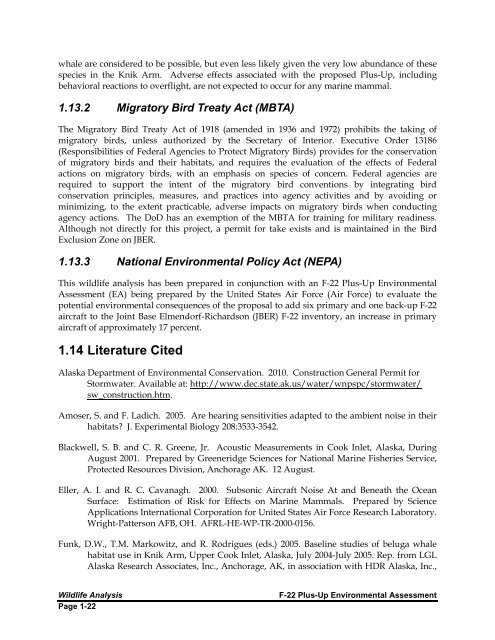F-22 Plus-Up Environmental Assessment - Joint Base Elmendorf ...
F-22 Plus-Up Environmental Assessment - Joint Base Elmendorf ...
F-22 Plus-Up Environmental Assessment - Joint Base Elmendorf ...
You also want an ePaper? Increase the reach of your titles
YUMPU automatically turns print PDFs into web optimized ePapers that Google loves.
whale are considered to be possible, but even less likely given the very low abundance of these<br />
species in the Knik Arm. Adverse effects associated with the proposed <strong>Plus</strong>-<strong>Up</strong>, including<br />
behavioral reactions to overflight, are not expected to occur for any marine mammal.<br />
1.13.2 Migratory Bird Treaty Act (MBTA)<br />
The Migratory Bird Treaty Act of 1918 (amended in 1936 and 1972) prohibits the taking of<br />
migratory birds, unless authorized by the Secretary of Interior. Executive Order 13186<br />
(Responsibilities of Federal Agencies to Protect Migratory Birds) provides for the conservation<br />
of migratory birds and their habitats, and requires the evaluation of the effects of Federal<br />
actions on migratory birds, with an emphasis on species of concern. Federal agencies are<br />
required to support the intent of the migratory bird conventions by integrating bird<br />
conservation principles, measures, and practices into agency activities and by avoiding or<br />
minimizing, to the extent practicable, adverse impacts on migratory birds when conducting<br />
agency actions. The DoD has an exemption of the MBTA for training for military readiness.<br />
Although not directly for this project, a permit for take exists and is maintained in the Bird<br />
Exclusion Zone on JBER.<br />
1.13.3 National <strong>Environmental</strong> Policy Act (NEPA)<br />
This wildlife analysis has been prepared in conjunction with an F-<strong>22</strong> <strong>Plus</strong>-<strong>Up</strong> <strong>Environmental</strong><br />
<strong>Assessment</strong> (EA) being prepared by the United States Air Force (Air Force) to evaluate the<br />
potential environmental consequences of the proposal to add six primary and one back-up F-<strong>22</strong><br />
aircraft to the <strong>Joint</strong> <strong>Base</strong> <strong>Elmendorf</strong>-Richardson (JBER) F-<strong>22</strong> inventory, an increase in primary<br />
aircraft of approximately 17 percent.<br />
1.14 Literature Cited<br />
Alaska Department of <strong>Environmental</strong> Conservation. 2010. Construction General Permit for<br />
Stormwater. Available at: http://www.dec.state.ak.us/water/wnpspc/stormwater/<br />
sw_construction.htm.<br />
Amoser, S. and F. Ladich. 2005. Are hearing sensitivities adapted to the ambient noise in their<br />
habitats? J. Experimental Biology 208:3533-3542.<br />
Blackwell, S. B. and C. R. Greene, Jr. Acoustic Measurements in Cook Inlet, Alaska, During<br />
August 2001. Prepared by Greeneridge Sciences for National Marine Fisheries Service,<br />
Protected Resources Division, Anchorage AK. 12 August.<br />
Eller, A. I. and R. C. Cavanagh. 2000. Subsonic Aircraft Noise At and Beneath the Ocean<br />
Surface: Estimation of Risk for Effects on Marine Mammals. Prepared by Science<br />
Applications International Corporation for United States Air Force Research Laboratory.<br />
Wright-Patterson AFB, OH. AFRL-HE-WP-TR-2000-0156.<br />
Funk, D.W., T.M. Markowitz, and R. Rodrigues (eds.) 2005. <strong>Base</strong>line studies of beluga whale<br />
habitat use in Knik Arm, <strong>Up</strong>per Cook Inlet, Alaska, July 2004-July 2005. Rep. from LGL<br />
Alaska Research Associates, Inc., Anchorage, AK, in association with HDR Alaska, Inc.,<br />
Wildlife Analysis<br />
Page 1-<strong>22</strong><br />
F-<strong>22</strong> <strong>Plus</strong>-<strong>Up</strong> <strong>Environmental</strong> <strong>Assessment</strong>
















